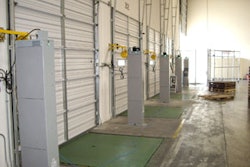Is your supply chain technology driving increased profitability for your business? When supply chains are performing less than optimally, it is usually a sign of poor decision making. Having the right supply chain technology in place will enable superior decision making in a company's key supply chain functions and ensure an efficiently run supply chain. However, understanding what to reasonably expect, and what not to expect, from supply chain tools isn't always clear. At a minimum, supply chain technology should establish a foundation on which to operate world-class supply chain processes that enable people to make the best decision for the business. Only a few leading-edge companies are getting the most out of their technology by leveraging it to achieve maximum business profitability.
The Four Pillars of Supply Chain Technology
At a minimum, it's important for supply chain technology to provide four foundational pillars to the business. They are:
1. Data visibility. Supply chain tools are a window into what is happening in the business: What do customers want, how much and when? What can manufacturing sites produce and with what reliability? What are the costs for each stage of the supply chain from sourcing raw materials, through making the products, to distributing them to customers? Where are the bottlenecks in the supply chain, and how are the associated risks being managed?
When the data that represent all these activities are visible, people can respond in a timely and effective manner. In addition, having a common source of data for all the decision-makers allows coordinated and consistent responses. And having reliable data reduces the waste that accumulates when each person hedges for uncertainty in the system by adding "just a little" extra inventory, reserving "just a little" production capacity or holding back "just a little" on the sales forecast.
2. Data "slice- and dice-ability." Detailed data of supply chain operations can be overwhelming. Furthermore, different members of the supply chain team, accountable for different performance metrics, may want to see the data in different ways. That's why supply chain technology should be able to provide customized views into the data required to make decisions, at the level of detail pertinent to the individual decision-maker. For example, sales people may need to see customer forecasts and historical sales at a product-customer level in order to effectively create their sales strategies, while regional sales managers may want to see data aggregated to product or region.
3. Focus on the right problem area. Supply chain technology needs to support the critical decisions that affect profitability. There is an astounding array of supply chain support tools available in the marketplace, ranging from demand planning to supplier relationship management to transportation planning and vehicle routing, just to name a few. Which ones will have the biggest impact on improving profitability? Which ones would be a waste of money? The answers are different for each business.
Selecting the right technology depends on an understanding of the primary drivers of supply chain performance for the business. For example, in a long-lead-time supply chain, forecasting and planning may enable better preparation by having the right raw materials and production plan in place to meet customer orders. Effective inventory management technology can support critical decisions of where and how much inventory to keep in different stages of the supply chain. With short lead times, on the other hand, focusing on speed, flexibility and execution accuracy becomes more critical. Implementing effective production scheduling and distribution management tools that permit a dynamic response to fast-changing conditions is likely to be of greater value than a sophisticated forecasting system.
4. Alignment with organization and process. To aid in decision making, technology tools (and the way they are implemented) need to align with the organization that is making the decisions and with that organization's business processes. Often, this comes down to the user-tool interface and the "care and feeding" required by the tool. For example, if the tool requires a high level of inventory accuracy to yield good decisions, the organization and processes must be capable of delivering that inventory accuracy both in the warehouse and in the timely feeds of data into the tool. (It doesn't help to have the accuracy on paper, but not in the tool that needs the data.)
Finally, alignment means that key decision-makers up and down the supply chain organization must have adequate access to all the information they need to make their decisions. Sometimes this is no easy task, with "separation-of-duties" requirements that have been forced into the supply chain by Sarbanes-Oxley legislation or similar regulatory requirements. It is important to make sure that "separation-of-duties" doesn't end up becoming "separation-of-process."
Once these pillars are in place, the technology may be exploited further as a competitive advantage to drive businesses profitability.
Supply Chain Technology for Competitive Advantage
While all businesses need to identify the critical supply chain decisions that drive profitability and choose the proper technology to support those decisions, smart businesses also leverage supply chain technology for competitive advantage. They have a deeper appreciation of the uncertainty their businesses face every day and can make decisions that lead to profitability under a wide range of possible futures. Typically these businesses are using advanced decision-making tools that have one or more of the following features:
- Scenario analysis
- Business optimization
- Risk assessment
Effective scenario analysis allows decision-makers to test the impact of their decisions under many possible futures. We all know the sales forecast is wrong, but not by how much and in which direction. Prices for energy, transportation and raw materials have been fluctuating wildly. The rise of a larger middle class in India, China and other "low-cost countries," along with the rise in fuel prices, brings new scrutiny to what once looked like smart global sourcing decisions. Scenario analysis tools allow decision-makers to analyze performance across a wide range of scenarios and choose a solution that may not be the absolute "best" decision in any given scenario, but results in the "best" overall performance across all of the scenarios. Understanding how decisions today will affect the business tomorrow is invaluable for those who want to plan for profitability beyond the next quarter.
Optimization technology is entering its heyday. The quantity, quality and depth of company data are astounding. Optimization technology now enables the thought leaders in supply chain processes to make decisions that squeeze out additional percentage points of profitability and that are robust enough to do well under varying conditions in the marketplace. For example, a major automobile parts supplier that imports the majority of its stock from overseas has embedded an optimization routine into the container offloading process, resulting in a 16 percent increase in daily offload and a corresponding decrease in cost. This success was only possible because the supplier had accurate knowledge of the contents of the containers being offloaded and the need for those parts in its distribution centers around the country.
Risk assessment and analysis is the newest frontier in supply chain decision making. Decisions that look excellent given a traditional set of assumptions about what customers, competitors and suppliers are doing don't always turn out to be correct, and the pain from a wrong choice can be extraordinary. Risk assessment tools, often based on simulation technologies and statistical analysis, can help companies understand and manage the risks. Consider the plight of Boeing's 787 Dreamliner program. First, Boeing failed to consider the risk that its suppliers would have difficulty supplying subassemblies instead of the individual parts they had supplied in the past. Then, once the subassemblies started to arrive, the whole operation ground to a halt because there were not enough fasteners to assemble the plane in the Everett, Wash., factory. Clearly, Boeing's approach to managing the risk of mundane parts supply outages helped to kick it when it was already down.
The Best of Both Worlds
In 1997, world chess champion Garry Kasparov played against IBM's Deep Blue Supercomputer and lost. The following day he spoke about his experience and proposed a change in perspective: The real challenge is not to determine who is superior — man or machine — but to achieve the right combination of man and machine. This insight also applies to supply chain operations. First and foremost, people and their experience and sound judgment are necessary to make the right decisions. However, understanding how supply chain software can complement and extend human abilities, will improve performance and achieve maximum profitability. The right combination of technology and human brain power leads to the most informed decisions and best results.










